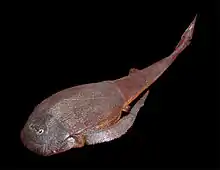Austroptyctodus
Austroptyctodus gardineri is a small ptyctodontid placoderm fish from the Upper Devonian Gogo Formation of Western Australia. First described by Miles & Young (1977)[1] as a new species of the German genus Ctenurella. Long (1997)[2] redescribed the German material and found major differences in the skull roof pattern so assigned it to a new genus, Austroptyctodus. This genus lacks spinal plates and has Ptyctodus-like toothplates.
| Austroptyctodus Temporal range: Late Frasnian | |
|---|---|
| Scientific classification | |
| Kingdom: | Animalia |
| Phylum: | Chordata |
| Class: | †Placodermi |
| Order: | †Ptyctodontida |
| Family: | †Ptyctodontidae |
| Genus: | †Austroptyctodus Long, 1997 |
| Species: | †A. gardineri |
| Binomial name | |
| †Austroptyctodus gardineri Long, 1997 | |
| Synonyms | |
| |
The most significant discovery about Austroptyctodus is that one specimen depicts a female pregnant with 3 unborn embryos inside her, showing that like Materpiscis, also from Gogo, this genus was a live bearer that reproduced through internal fertilization.[3]
References
- Miles, R.S. & Young, G.C. 1977. Placoderm interrelationships reconsidered in the light of new ptyctodontids from Gogo Western Australia. Linn. Soc. Symp. Series 4: 123-198.
- Long, J.A. 1997. Ptyctodontid fishes from the Late Devonian Gogo Formation, Western Australia, with a revision of the German genus Ctenurella Orvig 1960. Geodiversitas 19: 515-555.
- Long, J.A., Trinajstic, K.,Young, G.C. & Senden, T. 2008. Live birth in the Devonian period. Nature 453: 650-653.
This article is issued from Wikipedia. The text is licensed under Creative Commons - Attribution - Sharealike. Additional terms may apply for the media files.

